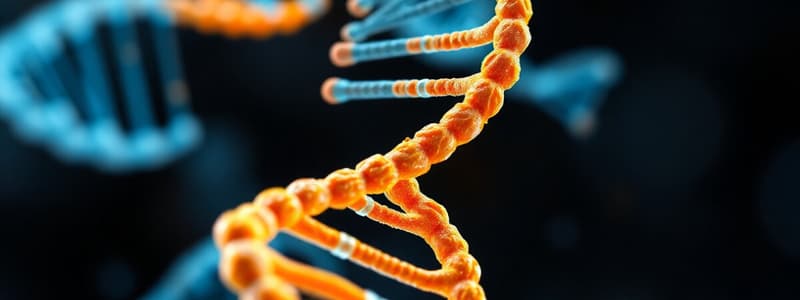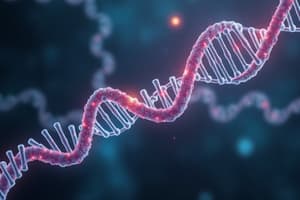Podcast
Questions and Answers
What is the primary role of hydrogen bonds in DNA structure?
What is the primary role of hydrogen bonds in DNA structure?
- To provide energy for DNA replication
- To facilitate the formation of phosphodiester bonds
- To hold the two polynucleotide strands together (correct)
- To protect the genetic sequence from mutation
How does the hydrogen bonding between bases contribute to DNA stability?
How does the hydrogen bonding between bases contribute to DNA stability?
- By forming covalent bonds which cannot be broken
- By allowing random base pairing without specificity
- By providing structural support without breaking easily (correct)
- By allowing strands to separate easily without replication
What is meant by semi-conservative replication of DNA?
What is meant by semi-conservative replication of DNA?
- Only the leading strand is replicated while the lagging strand is left untouched
- Each daughter DNA molecule contains two newly synthesized strands
- Each daughter DNA molecule contains one old strand and one new strand (correct)
- Both strands of DNA are completely degraded during replication
Which enzyme is responsible for breaking hydrogen bonds during DNA replication?
Which enzyme is responsible for breaking hydrogen bonds during DNA replication?
Why is the genetic code considered universal?
Why is the genetic code considered universal?
What characteristic of the genetic code allows for the presence of multiple codons for the same amino acid?
What characteristic of the genetic code allows for the presence of multiple codons for the same amino acid?
What is the main function of the sugar-phosphate backbone in DNA?
What is the main function of the sugar-phosphate backbone in DNA?
Which factor primarily prevents spontaneous mutation in DNA?
Which factor primarily prevents spontaneous mutation in DNA?
What role does DNA ligase play in the replication process?
What role does DNA ligase play in the replication process?
What does the term 'triplet code' refer to in genetics?
What does the term 'triplet code' refer to in genetics?
What three components make up a nucleotide?
What three components make up a nucleotide?
What is the primary function of ATP in cells?
What is the primary function of ATP in cells?
How are polynucleotide chains formed?
How are polynucleotide chains formed?
Which bases are found in RNA but not in DNA?
Which bases are found in RNA but not in DNA?
What type of bond holds the two strands of DNA together?
What type of bond holds the two strands of DNA together?
What is a characteristic of DNA strands?
What is a characteristic of DNA strands?
Which of the following is not a use of ATP?
Which of the following is not a use of ATP?
What sugar is present in DNA nucleotides?
What sugar is present in DNA nucleotides?
Which nucleotides form adenosine triphosphate (ATP)?
Which nucleotides form adenosine triphosphate (ATP)?
What type of reaction is involved in forming a mononucleotide from its components?
What type of reaction is involved in forming a mononucleotide from its components?
Flashcards are hidden until you start studying
Study Notes
Structure of DNA and RNA
- Nucleic acids consist of polynucleotides formed by linking nucleotides via phosphodiester bonds.
- Nucleotides are composed of a phosphate group, a pentose sugar (deoxyribose in DNA, ribose in RNA), and a nitrogenous base.
- Formation of a mononucleotide involves a condensation reaction resulting in the elimination of two water molecules.
Nitrogenous Bases
- DNA contains five nitrogenous bases: adenine (A), thymine (T), guanine (G), and cytosine (C).
- RNA replaces thymine with uracil (U), comprising adenine (A), uracil (U), guanine (G), and cytosine (C).
- Adenosine triphosphate (ATP) is a phosphorylated mononucleotide made from ribose, adenine, and can have one to three phosphate groups (AMP, ADP, ATP).
ATP Significance
- ATP is termed the universal energy currency for cells.
- It is small and water-soluble, facilitating easy diffusion between cell organelles.
- Acts as an immediate energy donor, easily hydrolyzed to ADP to release energy.
Uses of ATP
- Vital for cell division, muscle contraction, and maintenance of body temperature.
- Plays a role in anabolic reactions, such as protein synthesis and nerve impulse transmission.
Formation of Polynucleotide
- Occurs during interphase through condensation reactions creating phosphodiester bonds.
- Links the phosphate of one nucleotide to the 3' carbon of the sugar in another nucleotide, creating a sugar-phosphate backbone.
Structure of DNA Molecule
- Comprises two polynucleotide strands of deoxyribose, phosphate, and nitrogenous bases.
- Strands run in opposite directions (antiparallel).
- Hydrogen bonds between nitrogenous bases connect the strands, adhering to complementary base pairing (A=T, G≡C).
Importance of Hydrogen Bonding in DNA
- Hydrogen bonds hold the two polynucleotide strands together and contribute to the DNA's 3D structure.
- Provide stability, allowing for easier separation during replication and transcription.
- Specificity in base pairing reduces replication errors, ensuring faithful genetic replication.
Structural Features Contributing to DNA Stability
- Complementary base pairing and numerous hydrogen bonds enhance structural integrity.
- The sugar-phosphate backbone is reinforced with phosphodiester bonds.
- The double helix configuration protects bases from chemical attacks.
Importance of DNA Stability
- Prevents spontaneous changes in sequences, minimizing mutation risk and ensuring functional proteins.
- Ensures the preservation of genetic information across generations, maintaining integrity in daughter cells.
- Keeps DNA size manageable for storage within the nucleus.
Semi-Conservative Replication of DNA
- Semi-conservative replication generates two identical DNA molecules, each containing one original and one new strand.
- Occurs during the S phase of the cell cycle, using each old strand as a template for new complementary strand synthesis.
Steps of DNA Replication
- The double helix unwinds, and hydrogen bonds between complementary bases break, facilitated by the enzyme DNA helicase.
- Free activated nucleotides align along the separated strands, pairing with complementary bases (A=T, C≡G).
- DNA polymerase adds new nucleotides sequentially, while DNA ligase forms phosphodiester bonds between adjacent nucleotides.
Sense and Anti-sense Strands
- Sense strand encodes for protein manufacture, while anti-sense strand stabilizes the DNA and serves as a template for mRNA synthesis.
- A triplet of bases (codon) in the template strand codes for one amino acid, forming the genetic code.
Genetic Code Characteristics
- Each triplet of bases specifies one amino acid, resulting in 64 possible codons from four bases.
- The genetic code is universal across living organisms, suggesting a common ancestry.
- Degenerate nature allows multiple codons to code for the same amino acid, totaling 61 codons usable for amino acids and three stop codons.
Studying That Suits You
Use AI to generate personalized quizzes and flashcards to suit your learning preferences.




